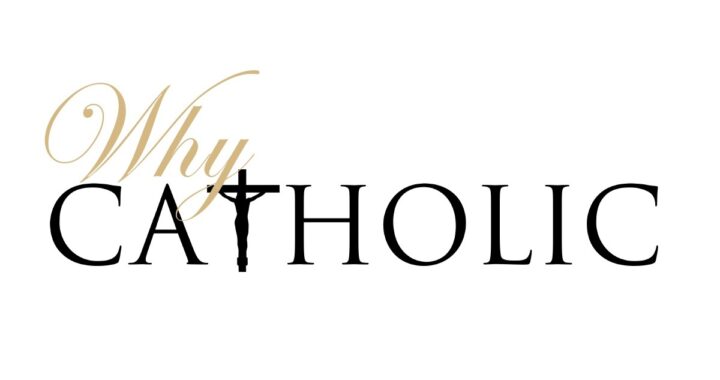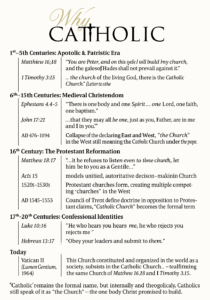For over two thousand years, the Catholic Church has stood as the visible, unified body of Christ, preserving the same faith, sacraments, and leadership established by the apostles. While many Christian communities share elements of the Gospel, only the Catholic Church can trace an unbroken line of apostolic succession back to Peter and the first apostles — the men personally chosen and commissioned by Jesus Himself.
This historical and spiritual continuity is not just a point of pride; it is a fulfillment of Christ’s promise to build His Church and safeguard it against the powers of darkness (Matthew 16:18).
1st–5th Centuries: Apostolic & Patristic Era
Biblical foundation in use:
-
Matthew 16:18 — “You are Peter, and on this rock I will build my church, and the gates of Hades shall not prevail against it.” (One Church, singular)
-
1 Timothy 3:15 — “…the church of the living God, the pillar and foundation of the truth.” (One visible, authoritative body)
Events:
-
c. 30–100 AD — Apostles lead the early Church; “the Church” means the universal body of believers in unity with apostolic authority.
-
110 AD — St. Ignatius of Antioch: “Wherever Jesus Christ is, there is the Catholic Church.” (Letter to the Smyrnaeans, 8:2) — first recorded use of “Catholic” to mean universal.
-
325 AD — Nicene Creed declares belief in “one, holy, catholic, and apostolic Church.” The adjective catholic means “universal,” not denominational.
6th–15th Centuries: Medieval Christendom
Biblical foundation emphasized:
-
Ephesians 4:4–5 — “There is one body and one Spirit… one Lord, one faith, one baptism.”
-
John 17:21 — “…that they may all be one, just as you, Father, are in me and I in you.”
Events:
-
476–1054 AD — Collapse of the Western Roman Empire; papal primacy solidifies in the West. “The Church” refers to the Roman, papal-led Church.
-
1054 AD — Great Schism divides East and West; in the West, “the Church” still means the Catholic Church under the pope.
-
12th–15th Centuries — Small heretical movements emerge, but Catholicism dominates Western Christianity.
16th Century: The Protestant Reformation
Biblical foundation reaffirmed:
-
Matthew 18:17 — “…if he refuses to listen even to the church, let him be to you as a Gentile…” (Presumes a visible, authoritative Church)
-
Acts 15 — The Council of Jerusalem models unified, authoritative decision-making in the Church.
Events:
-
1517 AD — Martin Luther’s 95 Theses spark widespread dissent.
-
1520s–1530s — Protestant churches form, creating multiple competing “churches” in the West.
-
1545–1563 AD — Council of Trent defines doctrine in opposition to Protestant claims. The term “Catholic Church” becomes the formal designation to distinguish it from Protestant bodies.
17th–20th Centuries: Confessional Identities
Biblical foundation preserved in Catholic catechesis:
-
Luke 10:16 — “He who hears you hears me; he who rejects you rejects me.”
-
Hebrews 13:17 — “Obey your leaders and submit to them…”
Events:
-
1600s–1700s — Protestant-majority nations adopt “Roman Catholic Church” to distinguish from their state churches.
-
1800s–1900s — The Catholic Church continues to stress its claim to being the one true Church founded by Christ.
Today
Biblical continuity:
-
Vatican II (Lumen Gentium, 1964): “This Church constituted and organized in the world as a society, subsists in the Catholic Church…” — reaffirming the same Church of Matthew 16:18 and 1 Timothy 3:15.
Events:
-
The Church remains called “Catholic” in formal use, but internally and theologically, Catholics still speak of it as “the Church” — the one body Christ promised to build.
The One Holy, Catholic & Apostolic Church
-
Apostolic Succession
-
Catholic bishops are ordained in a line that the Church holds goes back to the apostles, through the laying on of hands (cf. Acts 1:20–26; 2 Timothy 2:2).
-
This succession is both sacramental (authority to teach, sanctify, and govern) and doctrinal (faithfully handing on the apostolic teaching).
-
-
Historical Continuity
-
From Peter and the apostles in the 1st century to Pope Francis today, the Catholic Church maintains an unbroken episcopal lineage.
-
Early Church Fathers — such as St. Irenaeus (Against Heresies, c. 180 AD) — listed the bishops of Rome as a way to prove the authenticity of the Church’s teaching against heresies.
-
-
Contrast with Other Churches
-
Eastern Orthodox Churches also claim apostolic succession but are in schism from Rome since 1054.
-
Protestant communities, emerging in the 16th century, generally reject or have lost apostolic succession in the Catholic sense.
-
-
Theological Significance
-
The Catholic Church sees this continuity as part of Christ’s promise in Matthew 16:18 — that the Church He founded would never be overcome.
-
The Church is therefore not just “like” the early Church; it is the same Church, growing organically through history.
-



Pingback: Lord Of The Rings Author J.R.R. Tolkien Catholic Faith and Influence